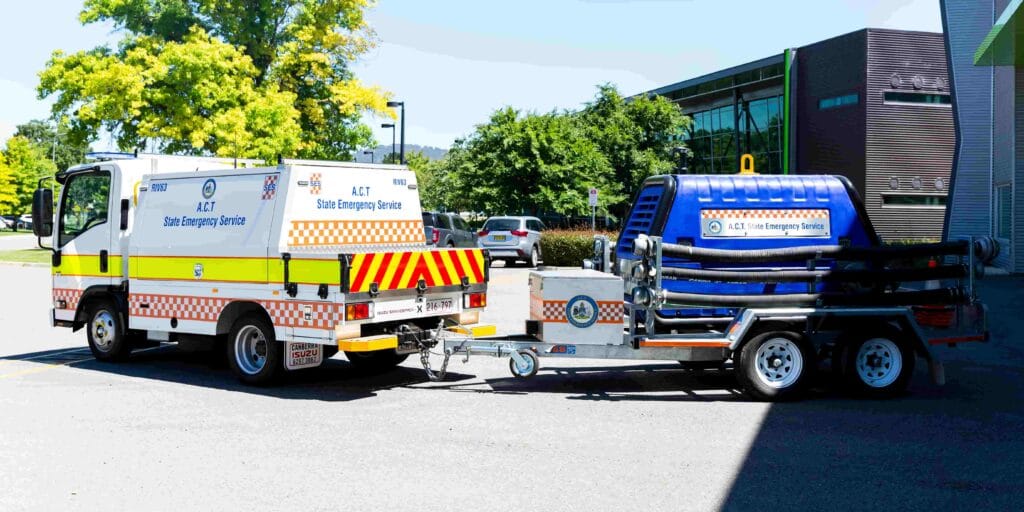Anthony Draheim, the new chief officer of the ACT State Emergency Service, determined a decade ago on emergency management as a career move when he transitioned out of Defence.
“It’s critical that anyone who’s been in Defence has a plan to leave it,” he said. “Defence is very different to normal community and society in regards to what government asks us to do – but very similar to what government asks the State Emergency Services and the Emergency Services Agency (ESA) [under which the SES sits] to do.”
Mr Draheim leads almost 400 volunteers and permanent staff who keep the community safe from storms and floods, and are involved in search and rescue operations. He comes to the position after more than 30 years in the Australian Army, most recently as Chief of Staff for the Royal Military College (Duntroon).
He had experience in emergency experience through his army work; he has commanded and managed Defence logistics, and had planned and supported humanitarian aid and military disaster responses both in Australia and overseas, including in Iraq, Afghanistan and Kuwait.
Mr Draheim has been an SES volunteer himself for several years, serving with both the ACT and NSW branches to see whether emergency management would be a good fit, and to understand the differences between the hierarchical, highly structured, fully paid army and the SES’s committed volunteers.
Those volunteers are the SES’s main strength, according to Mr Draheim. “They are the SES,” he said. “I’m their leader, but without any of the volunteers in this organisation (or across the ESA, which has a number of volunteers in various roles and functions), without them we cannot operate. Without them, the safety and protection of the ACT community could not happen.”
Mick Gentleman, Minister for Police and Emergency Services, appointed Mr Draheim chief officer on 3 December, following his engagement in January as director of training co-ordination and management with the ACT ESA.
Mr Draheim succeeds former chief officer Georgeina Whelan, who was promoted to Commissioner of the ACT ESA last October. Jeff Butler and Superintendent Matt Shonk have acted in the position in the interim.
A week into his new job, Mr Draheim seemed confident and relaxed. “It’s gone pretty well so far,” he said.
Mr Draheim said he spent part of his first week getting to know his team, the volunteers, and the rest of the organisation. “How do I fit into a system that’s already running very smoothly? A change of leadership should be a little bit seamless. In this case, I think it has,” he said.
The rest of the week he has spent dealing with day-to-day business: briefs, media conferences, meetings, committees, and the occasional storm.
Mr Draheim believes his primary function is to support the volunteers: to make sure they get the necessary training, support, and equipment they need to protect the community.
“I need to be their drive and their voice at the table for seeking funding, support and government requirements,” he said. “They want to give back to their communities, in whatever they can; a lot of them give up a lot of time, effort and energy to do that.”
Mr Draheim also wants to “enhance what is already a fantastic foundation”, continuing his predecessors’ work in recruiting more younger people, more women, and making the SES more diverse. At present, he said, the organisation has information on age brackets but little other demographic information; over the next six months, SES members will be surveyed to better understand their needs and wants.
The SES has a full complement of volunteers at the moment, but will recruit 30 to 40 people next year. There was a large intake of volunteers following the bushfires, Mr Draheim said, but he expected a fall-off in numbers next year.
La Niña will bring a wetter summer than last – and with it unpredicted storms and the possibility of flash flooding. Fortunately, Mr Draheim said, his predecessors had placed the SES in a great position; volunteers had trained from March to September.
“We are ready and prepared,” he said.
On Wednesday, too, Mr Draheim and Mr Gentleman revealed the SES’s first high-capacity three-person truck, whose 6,000 L pump can clear floods from underground carparks and basements quickly. Previously, two vehicles were needed to transport the heavy pump and trailer.

“Having the ability to send one vehicle instead will increase emergency services’ capability and response time,” Mr Draheim said.
“The vehicle will go to great use in the ACT. When not responding to major flood incidents, it can be used for storm reconnaissance, logistics deliveries, field welfare, and bush and grass fire response.”
During the fire season, the pump can refill RFS tankers with water, keeping them on the fire line, Mr Draheim added.
“Canberrans should take comfort in the fact that our highly skilled members can now provide an even greater level of protection and service,” he said.
But he also urged the community to prepare themselves for the summer’s fires and storms. The ESA has run an education campaign both through pop-ups at community events and local shopping centres, and online through their website (https://esa.act.gov.au/).
The ESA has also developed a brand new survival plan for all hazards (replacing previous separate plans for stormwater, fire, and so forth).
“If you haven’t got a survival plan, download one from the website, and be prepared for any event,” Mr Draheim said.
For more news:
- Construction of Mitchell light rail stop to halt service between EPIC and Gungahlin
- Fears for young detainees’ safety, officers lack ‘basic practical training’
- Government wipes permit fees to encourage outdoor dining
- Shaping Mulligan’s Flat Woodland Sanctuary’s next 25 years
- National Opera will put Canberra on the international music map



